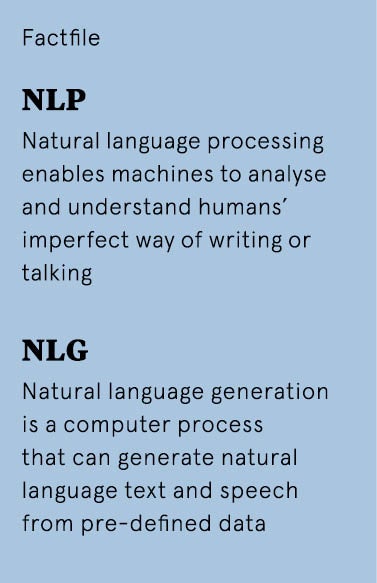Companies that aren’t investing in artificial intelligence (AI) risk falling behind their competitors. Yet because AI is an umbrella term for several different technologies that each have distinct uses, it is often challenging to know which solution is right for a particular work process.
The most well-known subsets of AI are robotic process automation for automating repetitive tasks, machine-learning to give computer systems the ability to “learn” and improve work processes, and natural language processing (NLP), which enables machines to analyse and understand humans’ imperfect way of writing or talking.
A lesser-known AI technology, however, is natural language generation (NLG). At its simplest, an NLG platform is a computer process that can generate natural language text and speech from pre-defined data. At its most advanced, it powers the responses given by AI assistants, such as Google Home and Amazon’s Alexa, when asked a question.
Though currently relatively nascent, the technology has huge potential for many industries, including journalism, finance, business service and healthcare, for both customer-facing and internal work processes.

Using Natural Language Generation to translate data
A booming use case for NLG is as a tool to translate the hordes of data businesses now collect into intelligent, understandable and actionable insights. A platform can be given a set of rules and parameters to work within, and then fed structured data to output reports, paragraphs and emails that appear as though written by a human.
Automated Insights’ NLG platform, called Wordsmith, was originally built to generate sports post-match recaps and player notes, but the company is now seeing an upswing in demand from firms wanting to generate business intelligence reports.
These include marketing analysis and coherent narratives derived from data straight into company dashboards, so complex statistics can be easily understood by everyone in an organisation without being verbally explained by analysts.
“This automates their expertise in a way everyone can understand to alleviate some of the manual work. Every company is collecting data and people want to know what it means immediately; NLG translates it into something anyone can read and understand,” explains the company’s marketing manager Laura Pressman.
NLG: turning numbers to narratives
This is a huge time saver for businesses. Associated Press, for example, produces 4,400 quarterly business recaps using Wordsmith. Every quarter, when a public company publishes its corporate earnings, instead of a journalist sifting through the information, the technology automatically scans and derives insights from each release, and translates it into written, plain language narrative.
In a similar vein, Emmanuel Walckenaer, chief executive of Yseop, an NLG software platform used by Moody’s, Zachs and Societe Général, says the technology can provide financial advisers with a coherently collated written summary of a client’s transaction history that offers recommendations on where they might like to invest next and why or whether they are risk adverse or not.
Typically, these insights will only be one or two paragraphs in length. Creating longer, more in-depth reports is possible, but requires more rules, protocols and system-training, and several weeks to build, which can be a barrier to adoption.
However, in this capacity the technology has great potential for any situation where data needs to be understood quickly, including complex compliance laws or investigating fraudulent data.
Mr Walckenaer says NLG is currently being used in a “simplistic” way, but disruption will come when it can generate intelligent, informal dialogue for customer interaction management through chatbots or AI assistants.
Helpful conversations - from gaming to customer service
In April, Call of Duty announced a beta release of the Alexa Skill for Call of Duty: WWII, which enables players to ask Amazon’s Alexa how they performed in their last computer game.
Through the home assistant, the gamer will get a response in a character’s tone of voice, giving them analysis of their performance comprising more than 20 factors. It also offers gaming tips and answers to 2,500 questions about the game and an individual player’s performance.
This is a cutting-edge technology that also requires NLP for the machine to understand the question and NLG to reply.
Apoorv Saxena, product manager for cloud AI and AI research at Google, says customer and machine-voice interaction is “the next level of technological difficulty” for NGL, but will eventually improve productivity and economies of scale.
“Businesses have a lot of inquiries they are not able to answer because someone can’t take the call, but if you have a chatbot to do it that helps scale small to medium-sized business and improve productivity,” he says.
The technology has great potential for any situation where data needs to be understood quickly
Like other AI technologies, NLG has advanced considerably over the last ten years, but there is still a lot of work to do around customisation and conversation. Furthermore, even for the more simple use-cases, such as generating reports, it can still take a few weeks to adopt.
Mr Saxena says the technology will evolve “but we don’t know how yet”, adding that Google is investing significantly in developing NLG.
Further down the line, perhaps there will be NLG voice systems that recognise when a customer is upset and adjust their tone accordingly or give basic financial advice over the phone based on a person’s financial statistics, freeing up staff for more complex tasks.

